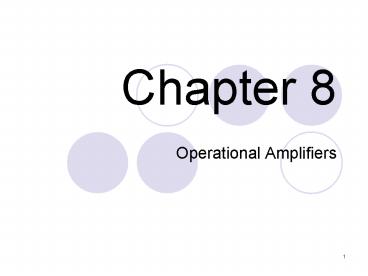Operational Amplifiers - PowerPoint PPT Presentation
1 / 49
Title:
Operational Amplifiers
Description:
Determine the loaded gain of an amplifier when connected between source and load. ... Decibel Response Forms. Butterworth Low-Pass Characteristics ... – PowerPoint PPT presentation
Number of Views:89
Avg rating:3.0/5.0
Title: Operational Amplifiers
1
Chapter 8
- Operational Amplifiers
2
Objectives
- Describe the properties of a voltage amplifier
and use a circuit model. - Define open circuit gain, input resistance, and
output resistance. - Determine the loaded gain of an amplifier when
connected between source and load. - Describe the properties of an operational
amplifier.
3
Objectives
- State and apply the ideal conditions used in
analyzing and designing op-amp circuits. - Analyze and describe the functions of various
op-amp circuits such as the inverting amplifier,
noninverting amplifier, and various controlled
sources. - Design op-amp circuits to perform amplification
and to function as controlled sources. - Analyze and design an op-amp linear combination
circuit and a difference amplifier.
4
Objectives
- Describe various integrator and differentiator
circuits using op-amps. - Discuss the advantages of active filters using
op-amps. - Design basic low-pass and band-pass active filter
circuits. - Describe how an op-amp can be used to create a
voltage regulator.
5
8-1 Amplifier Properties
- Voltage Amplifier Input-Output Characteristic
- General Properties
- Equivalent Circuit Model
- Input Resistance
- Open-Circuit Voltage Gain
- Output Resistance
- Connecting an Amplifier to a Source and a Load
- Ideal Voltage Amplifier
6
Block diagrams of voltage amplifiers showing
input and output voltages.
7
Typical input-output characteristics of
noninverting and inverting amplifiers in linear
region.
8
Amplifier input and output waveforms based on a
sinusoidal input.
9
Block diagram of amplifier showing input
resistance, open-circuit gain, and output
resistance.
10
Model of amplifier with source and load connected.
11
Amplifier model of Example 8-3.
12
Circuit model of Example 8-4.
13
8-2 Operational Amplifiers
- Power Supply Connections
- Block Diagram of Op-Amp with Power Supply
Connections - Block Diagram of Op-Amp Signal Terminals
- Inverting Input
- Noninverting Input
- Symbol Direction
14
8-2 Operational Amplifiers
- Defining Relationship
- Differential Input Voltage
- DC Coupling Effects
- Open-Loop Voltage
- Op-Amp Input-Output Characteristic
- Saturation Voltages
- Negative Feedback
15
Dual power supply configuration to provide power
for an op-amp.
16
Operational amplifier schematic diagrams.
17
Typical idealized input-output characteristics of
a representative op-amp.
18
8-3 Operational Amplifier Circuit Analysis
- Assumptions
- The input resistance of the op-amp as measured
between the noninverting and the inverting input
is infinite, meaning that it can be considered as
an open circuit. - The output resistance of the op-amp looking back
from the output terminals is zero, meaning that
the output dependent source may be considered as
an ideal voltage source.
19
8-3 Operational Amplifier Circuit Analysis
- Implications
- The implication of the infinite input resistance
is that the current flowing into or out of either
op-amp input terminal may be assumed to be zero. - The implication of the zero output resistance is
that any load connected to the output terminal
with respect to ground will not alter the
voltage. - The assumption of infinite gain is a little
harder to visualize, but let us assume that
somehow, the presence of negative feedback causes
the output voltage v0 to be finite. The
differential input voltage vd may then be
expressed as vd v0 / A.
20
8-3 Operational Amplifier Circuit Analysis
- Caution
- Although the assumption that the voltages at the
two input terminals are equal is valid for
analysis purposes, the two inputs cannot be
connected. - There will always be a small voltage across the
two terminals which, when multiplied by the
open-loop gain, will result in the actual voltage
output.
21
8-4 Inverting Amplifier Circuit
- Step-by-Step Analysis
- Discussion of Closed-Loop Gain
- Input and Output Resistances
- Summary
- Choosing Resistance Values for Design
22
Inverting amplifier circuit with labeling of
circuit variables.
23
Inverting amplifier circuit and a summary of its
properties.
24
Circuit of Examples 8-7 and 8-8.
25
8-5 Noninverting Amplifier Circuit
- Step-by-Step Analysis
- Input and Output Resistances
- Summary
- Alternate Configuration
- Voltage Follower
26
Noninverting amplifier circuit with labeling of
circuit variables.
27
Noninverting amplifier circuit shown two ways and
a summary of its properties.
28
Voltage follower circuit.
29
Circuit of Example 8-10.
30
8-6 Operational Amplifier Controlled Sources
- Voltage-Controlled Voltage Sources
- Current-Controlled Voltage Source
- Voltage-Controlled Current Source
- Current-Controlled Current Source
31
Current-controlled voltage source.
32
Voltage-controlled current source.
33
Current-controlled current source.
34
8-7 Circuits That Combine Signals
- Linear Combination Circuit
- Difference Amplifier
35
Linear combination circuit.
36
Difference amplifier configuration.
37
Circuit of Example 8-15.
38
8-8 Integration and Differentiation Circuits
- Ideal Op-Amp Integrator Circuit
- Possible Problems with Ideal Integrator
- AC Integrator
- Ideal Op-Amp Differentiator Circuit
- Possible Problems with Ideal Differentiator
- Low-Frequency Differentiator
39
Op-amp integrator circuits.
40
Op-amp differentiator circuits.
41
8-9 Active Filters
- Why Active Filters?
- Filter Response Characteristic Forms
- Decibel Response Forms
- Butterworth Low-Pass Characteristics
- Several Low-Pass Butterworth Filter Design Forms
- Two-Pole Band-Pass Responses Revisited
42
Several Butterworth low-pass amplitude response
forms.
43
Second-order low-pass Butterworth filter.
44
Third-order low-pass Butterworth filter.
45
Fourth-order low-pass Butterworth filter.
46
Several two-pole band-pass amplitude response
forms.
47
Second-order band-pass active filter that
exhibits the properties of a resonant circuit.
48
8-10 Voltage Regulation with an Op-Amp
- Regulator Circuit
49
Voltage regulator circuit using an op-amp and a
pass transistor.































